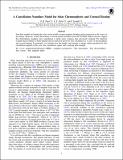Files in this item
A cancellation nanoflare model for solar chromospheric and coronal heating
Item metadata
| dc.contributor.author | Priest, E. R. | |
| dc.contributor.author | Chitta, L. P. | |
| dc.contributor.author | Syntelis, P. | |
| dc.date.accessioned | 2018-08-15T15:30:13Z | |
| dc.date.available | 2018-08-15T15:30:13Z | |
| dc.date.issued | 2018-08-01 | |
| dc.identifier | 255392376 | |
| dc.identifier | 214dbde2-6c88-48a4-8f04-305c73d38c7e | |
| dc.identifier | 85051544518 | |
| dc.identifier | 000440575200004 | |
| dc.identifier.citation | Priest , E R , Chitta , L P & Syntelis , P 2018 , ' A cancellation nanoflare model for solar chromospheric and coronal heating ' , Astrophysical Journal Letters , vol. 862 , no. 2 , L24 . https://doi.org/10.3847/2041-8213/aad4fc | en |
| dc.identifier.issn | 2041-8205 | |
| dc.identifier.other | BibCode: 2018ApJ...862L..24P | |
| dc.identifier.other | ORCID: /0000-0003-3621-6690/work/74117761 | |
| dc.identifier.other | ORCID: /0000-0002-6377-0243/work/77131791 | |
| dc.identifier.uri | https://hdl.handle.net/10023/15826 | |
| dc.description | L.P.C. received funding from the European Union’s Horizon 2020 research and innovation programme under the Marie Skłodowska-Curie grant agreement No. 707837. The German contribution to SUNRISE and its reflight was funded by the Max Planck Foundation, the Strategic Innovations Fund of the President of the Max Planck Society (MPG), DLR, and private donations by supporting members of the Max Planck Society. The Spanish contribution was funded by the Ministerio de Economía y Competitividad under Projects ESP2013-47349-C6 and ESP2014-56169-C6, partially using European FEDER funds. | en |
| dc.description.abstract | Nanoflare models for heating the solar corona usually assume magnetic braiding and reconnection as the source of the energy. However, recent observations at record spatial resolution from the SUNRISE balloon mission suggest that photospheric magnetic flux cancellation is much more common than previously realized. We therefore examine the possibility of three-dimensional reconnection driven by flux cancellation as a cause of chromospheric and coronal heating. In particular, we estimate how the heights and amount of energy release produced by flux cancellation depend on flux size, flux cancellation speed, and overlying field strength. | |
| dc.format.extent | 7 | |
| dc.format.extent | 668142 | |
| dc.language.iso | eng | |
| dc.relation.ispartof | Astrophysical Journal Letters | en |
| dc.subject | Magnetohydrodynamics: MHD | en |
| dc.subject | Magnetic reconnection | en |
| dc.subject | Sun: atmosphere | en |
| dc.subject | Sun: chromosphere | en |
| dc.subject | Sun: corona | en |
| dc.subject | Sun: magnetic fields | en |
| dc.subject | QB Astronomy | en |
| dc.subject | QC Physics | en |
| dc.subject | T-NDAS | en |
| dc.subject.lcc | QB | en |
| dc.subject.lcc | QC | en |
| dc.title | A cancellation nanoflare model for solar chromospheric and coronal heating | en |
| dc.type | Journal article | en |
| dc.contributor.institution | University of St Andrews. Applied Mathematics | en |
| dc.identifier.doi | 10.3847/2041-8213/aad4fc | |
| dc.description.status | Peer reviewed | en |
| dc.identifier.url | https://arxiv.org/abs/1807.08161 | en |
This item appears in the following Collection(s)
Items in the St Andrews Research Repository are protected by copyright, with all rights reserved, unless otherwise indicated.

